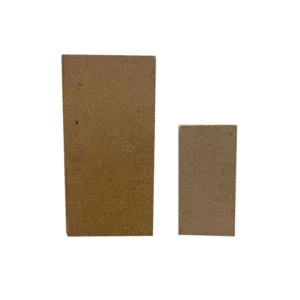Fire Clay Brick
Showing the single result
Laurel Group Supplies Quality Fire Clay Bricks
The Laurel Group is a leading supplier and manufacturer of refractory and insulation materials. Meanwhile, it includes fire clay brick, high alumina bricks, insulating bricks, chamotte brick, calcium silicate products, unshaped refractory materials, rock wool and glass wool products.
Composition Of Fire Clay Bricks
Fire clay bricks are made primarily from clay materials that are high in alumina (Al2O3) and silica (SiO2). The typical composition of fire clay brick includes:
- Silica (SiO2): 30-40% by weight. Silica helps increase the refractoriness and chemical stability of the bricks.
- Alumina (Al2O3): 40-50% by weight. Alumina is the main refractory component that provides high heat resistance and strength at high temperatures.
- Calcium carbonate (CaCO3): 1-5% by weight. Calcium carbonate is added as a flux to lower the firing temperature.
- Iron oxide (Fe2O3): 1-5% by weight. Iron oxide acts as a fluxing agent to lower the firing temperature and help liquid phase sintering of the bricks.
- Alkali oxides (Na2O, K2O): <1% by weight. Alkali oxides are added in very small quantities as essential ingredients but too much can make the bricks softening at high temperatures.
How To Produce Fire Clay Brick By Laurel Group?
The production process of fire clay bricks is quite similar to common bricks made. The usual 5 steps are below:
Digging for fire clay brick
- The raw materials required for fire clay bricks include fire clay, silica sand, alumina, lime, soda ash, etc. These raw materials are crushed and ground into a powder with a uniform particle size.
Moulding about fire clay bricks
- The mixed clay is as molded into bricks manually or using machineries like extruders and stamping machines. The molded bricks are air dried for some time.
Tempering is an important step
- Tempering is done after molding and before drying the bricks. The molded fire brick are allowed to rest for some time, typically 6-48 hours. This allows the particles to relax and lessen the chances of cracking during drying and firing.
Fireclay bricks with weathering control
- The molded bricks are dried in driers at a high temperature of 100-110°C to remove the moisture. This method may improve strength and hardness of the bricks.
- Some fire clay bricks are as glazed with a silicate glaze. And also fired again at a lower temperature. Glazing method will improve weather resistance of bricks.
Burning about clay bricks
- The dried bricks are fired in kilns at a very high temperature of 1,300-1,500°C. Firing bonds the particles together and develops the characteristic properties of fire clay bricks. Such as insulating ability, heat resistance, refractoriness, etc.
Fire Clay Brick With Many Applications
- Steel plants – Fire clay bricks are extensively used in steel plants for lining furnaces, kilns, converters, etc.
- Glass manufacturing – Fire clay bricks line glass furnaces and float tanks.
- Cement industries – Fire clay bricks line cement kilns and pre-heater towers.
- Incinerators – Fire clay bricks are used to line incinerators for burning waste at high temperatures.

